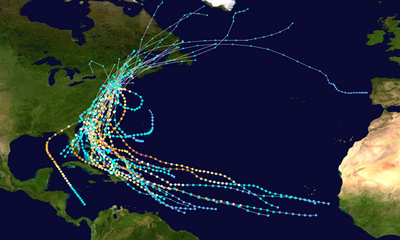This article needs additional citations for verification. (July 2017) |


A New England hurricane is a tropical cyclone originating in the Atlantic Ocean that affects the states of Connecticut, Rhode Island, Massachusetts, Vermont, New Hampshire, or Maine in the United States. Due to geography and climatology, the vast majority of tropical cyclone strikes to the New England region occur in Connecticut, Rhode Island, and eastern Massachusetts.
Since record keeping began for Atlantic tropical cyclones in 1851, there have been approximately 30 tropical cyclones to directly strike New England.[1] Due to the location of New England, most tropical cyclones that threaten the region tend to recurve out to sea, mainly due to upper-level steering patterns, such as the jet stream. Tropical cyclones also tend to weaken upon approach due to the cooler waters above 40 latitude (near southeastern Massachusette). Thus, tropical cyclone formation near New England and over the Gulf of Maine is very unfavorable. However, tropical cyclones moving up the East Coast can rapidly approach the Connecticut and Rhode Island coast before the encounter the cooler waters off southeast Massachusetts, and strike far southern New England as a category 3 hurricane. Both Connecticut and Rhode Island have been struck several times by a major hurricane since 1850.
Most commonly, New England will see the remnants or weakening stage of most tropical cyclones that make landfall either along the United States east coast or Gulf coast. This can sometimes lead to excessive rainfall, and in some cases destructive flooding. Hurricane Diane in 1955 produced over 19 inches of rain in Massachusetts and contributed to the 1955 Connecticut floods, one of the worst flooding events in Connecticut's history.[2] More recently, in 2011, a weakening Hurricane Irene produced historic flooding in Vermont, causing over $175 million in damage.[3]
The return period for hurricane and major landfalls along the coast of New England is highest in Connecticut and Rhode Island, and declines rapidly north toward Maine. Generally, the return period for hurricane force winds is 12-16 years along the coast of Connecticut and Rhode Island (which is for example higher than the coast of Georgia much farther south), to more than 50 years along the Maine coast.[4]
Due to the fact that sea surface temperatures from eastern Massachusetts northward are generally too cool to support a major tropical cyclone, the region very rarely sees a major hurricane landfall (Category 3 or higher). Since 1851, only 3 major hurricanes have ever made landfall on the New England coastline, and all of these were in Connecticut and Rhode Island. The return period for storms of such strength along the southern New England coastline is considered to be 50-70 years, and upwards of 300 years in coastal Maine.[5] As of 2022, the most recent major hurricane to make landfall in the region was Hurricane Carol in 1954.
On September 21, 1938, a Category 3 hurricane made landfall over New Haven, Connecticut with sustained winds of 115 mph (gusts of 150 mph) and a pressure of 941 millibars. Many coastal towns and cities on the Connecticut and Rhode Island coast suffered extreme damage. The coastal community of Napatree Point, Rhode Island was hit with a 20 - foot storm surge and the day after the cyclone was totally gone (34 killed). The cyclone produced very high wind gusts inland at higher elevations, delivering a 186 mph wind gust to the Blue Hill Observatory in Massachusetts, a 163 mph gust atop Mount Washington. A storm surge of 10-18 feet from Long Island Sound to Narragansett Bay, it is often considered to be the most intense hurricane to ever strike New England in modern times.[6] One estimate from Rhode Island stated the water level "reflects a storm occurring roughly once every 400 years. A study of sand deposits also gives more evidence that this was the strongest hurricane to hit Rhode Island in over 300 years, since 1635."[7]
- ^ "HURDAT2 April 08, 2022". www.aoml.noaa.gov. Retrieved November 9, 2022.
- ^ US Department of Commerce, NOAA. "Historic Flood August 1955". www.weather.gov. Retrieved November 9, 2022.
- ^ Schwartz, John (December 6, 2011). "Vermont Rebounding Quickly From Hurricane Irene". The New York Times. ISSN 0362-4331. Retrieved November 9, 2022.
- ^ Mets, WeatherNation (August 21, 2018). "A Look at the Frequency of a Hurricane Hitting Coastal Locations". WeatherNation. Retrieved November 9, 2022.
- ^ Mets, WeatherNation (August 21, 2018). "A Look at the Frequency of a Hurricane Hitting Coastal Locations". WeatherNation. Retrieved November 9, 2022.
- ^ Bowman, Dennis. "'38 Hurricane was no '100-year storm'". The Providence Journal. Retrieved November 9, 2022.
- ^ Bowman, Dennis (September 5, 2015). "'38 Hurricane was no '100-year storm'". The Providence Journal. Retrieved May 2, 2023.